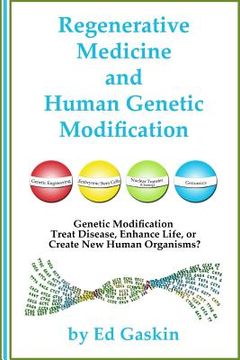Synopsis "Regenerative Medicine and Human Genetic Modification (in English)"
"Chinese scientists have genetically modified a human embryo again," read the headline. Genetic engineering of humans is no longer science fiction. The International Summit on Human Gene Editing was held to discuss critical issues in this area. Gene editing, a key tool for this work offers great promise but potential problems. Yet, there have not been any Congressional Hearings on the topic. In terms of the future of regenerative medicine, one just has to look at the Mexican Salamander, which has the ability to "regenerate" a limb when it is cut off. Image if someone who had a heart attack or needed a new kidney, and they could trigger their body to repair or grow them a new heart or kidney. There are many organisms in nature that have very long life spans or are considered "biologically immortal." Regenerative medicine is looking to understand what is happening with these animals at the genetic level and then apply those lessons to humans. We are much further ahead in the quest to genetically engineer humans than what most people realize. Imagine before you Tinker Toys or Legos of all different sizes, shapes and colors. Imagine those pieces are actually genes from insects, plants, animals and people that can be used interchangeably to provide humans characteristics only comic book superheroes possess. Scientists have already taken the gene that provides the jellyfish its green color and inserted it into the DNA of a white rabbit to create a "green rabbit." Scientists have taken the genes that enable spiders to make webbing and combined them with a goat's DNA as a way for the goat to make "spider silk", a strong new fiber. We can do similar things with human DNA. Genomics provides us the equivalent of the "Application Program Interface" (API) for each human. Genomics, genetic engineering, embryonic stem cells, and nuclear transfer (cloning) independently have great promise and peril for us. There are numerous similarities between computer programing and "genetic programing" or genetic modification. Instead of programing with zero's and one's, we use C, T, A, G. We can reprogram DNA, cells and genes. The excitement with these new technologies is we can more effectively treat chronic diseases such as Parkinson's disease, osteoarthritis, osteoporosis, age-related macular degeneration, and atherosclerosis, which accounts for over 75% of medical costs. There are over 3,000 genetic diseases such as sickle cell anemia we could treat. We could treat infectious diseases such as HIV by developing an HIV resistant immune system. However, there are also dangers. The same way computers and software can be hacked, genetic structures can be hacked. Genetic "doping" is possible. Because of the similarity between digital and genetic technologies, much of what we learned in the digital revolution can be transferred to the application of genetic modification and regenerative medicine. This similarity and the potential applications have not escaped the attention of companies such as Google who has created a company, Calico and is making major investments in these areas and are prepared to spend in the hundreds of millions for research. As a result of these powerful technologies we are on the brink of a genetic revolution similar in size and scope to the digital revolution (think biological versions of Google, Amazon, and Apple, but without any rules or guidelines). This book reviews the religious and scientific arguments, and refines the work of Norman Ford who was writing in the context of reproductive technologies, not the debates concerning embryonic stem cells and therapeutic cloning, and looks at where we are headed, with a focus on Dr. Michael West, a thought leader in this area. In terms of ethics, while some problems have been solved e.g. creating stem cells, use of cloning, the use of pre-implementation embryos for experimentation is still an issue. The chapter on the "Primitive Streak" addresses that issue.

